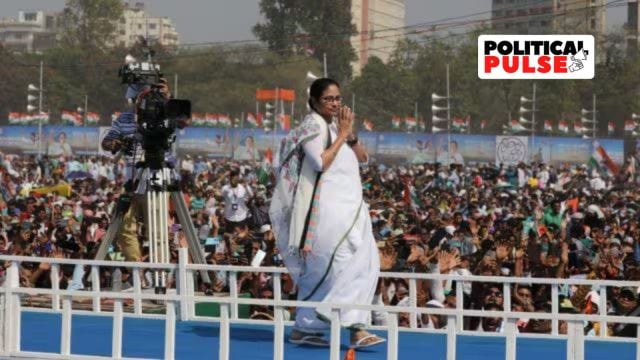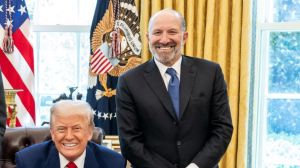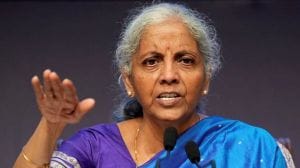As BJP rises in West Bengal, why TMC may have decided to go solo – it doesn’t lose by much
Combined vote shares of TMC, Congress were more in only 6 of 18 LS seats the BJP won in 2018; by 2021 Assembly polls, the dent for BJP would have been even lesser.
 The TMC, which came to power in 2011, has won the most Lok Sabha seats in the state since 2009. (Express file photo)
The TMC, which came to power in 2011, has won the most Lok Sabha seats in the state since 2009. (Express file photo)The three-cornered battle for West Bengal’s 42 Lok Sabha seats is beginning to take shape with the announcement of candidates by the BJP and the state’s ruling Trinamool Congress (TMC). While the BJP has named candidates for 20 seats so far, the TMC has announced all 42, ending any hopes of reaching a seat-sharing pact with INDIA bloc ally Congress.
Meanwhile, allies Left Front and Congress are struggling to put up a joint front. The former has already declared 16 names, and publicly expressed exasperation at the Congress failing to move ahead on seat-sharing.
Over the course of the past two decades, West Bengal’s political landscape has changed considerably – first with the rise of the TMC, founded in 1998, which shrank the Left’s influence; and then with the rise of the BJP, squeezing out both the Congress and Left.
The TMC, which came to power in 2011, has won the most Lok Sabha seats in the state since 2009.
 West Bengal Lok Sabha and Assembly seats
West Bengal Lok Sabha and Assembly seats
In the Assembly too, the TMC has maintained its dominance, winning 211 of 295 seats in 2016 and 215 in 2021. The Congress and Left have been steadily falling, from 44 and 33 seats in 2016, respectively, to none in 2021. The BJP has been the clear beneficiary of this decline, growing from 3 seats in 2016 to 77 in 2021.
In the Lok Sabha, the TMC has managed to stay ahead, but the concerted push by the BJP is showing results. In the Narendra Modi wave election of 2014, for example, when the BJP came to power at the Centre with a huge majority, the TMC won 34 of the 48 seats in Bengal. The Congress won 4 seats at the time, and the Left and BJP 2 each.
But by 2019, the BJP had narrowed the gap and won as many as 18 Lok Sabha seats in Bengal, just 4 short of the TMC’s 22. The Congress fell to 2 seats and the Left to none.
The BJP’s Lok Sabha victories were concentrated in the northern and eastern regions of Bengal, where the Left had been dominant.
 West Bengal Lok Sabha and Assembly vote shares.
West Bengal Lok Sabha and Assembly vote shares.
In terms of vote shares in the Lok Sabha polls, the TMC recorded a 3.9% point increase between 2014 and 2019 but still won 12 fewer seats. The BJP saw its vote share jump by 23.6% points while the Congress fell by 4% points and the Left by 22.4% points.
In Assembly polls, the TMC’s vote share grew by 3.1% points from 2016 to 2021. But again, the BJP’s rise was considerable – from 10.2% of the votes, to 38%. The Congress and the Left, on the other hand, fell by 9.3% points and 20.1% points, respectively.
Where a TMC-Congress-Left alliance might have made the difference
Of the 18 seats won by the BJP in 2019, in 9, the combined TMC, Congress and Left vote shares comfortably exceeded the BJP’s – 56.9% versus 40.6%. Given the rivalry between the TMC and Left, and the incongruity of the two of them coming together, if just the Congress vote shares were added to the TMC’s, the two would have been ahead of the BJP in 6 of the party’s 18 seats.
But going by the TMC’s performance in the 2021 Assembly polls, Mamata has reason to believe she doesn’t lose much contesting independently, at least in the 18 seats lost to the BJP in 2019. In terms of vote shares in the Assembly segments that make up these 18 Lok Sabha seats, the TMC was ahead of the BJP in 10. Adding the Congress’s Assembly segment vote share would have netted the combine 3 additional seats, while adding the Left too would have made difference in just 1 more seat.
Overall, the TMC-Congress-Left grouping secured a combined 56.7% of the votes share, while just the TMC and Congress together got 51%.
Photos




- 01
- 02
- 03
- 04
- 05


























